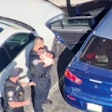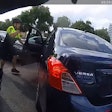The Fourth Amendment governs three forms of activity: searches (intrusions into privacy), seizures of the person (detentions and arrests), and seizures of property. If these acts are not authorized by judicial warrant, they must come within one or more of the court-created exceptions for warrantless search and seizure (Katz v. U.S.). One of these exceptions is called “plain view.”
Simply stated, if you are in a place where you have a right to be and you see accessible property in plain view that you recognize as contraband or the fruits, instrumentalities, or evidence of criminal activity, you may lawfully seize it (Warden v. Hayden). A number of Supreme Court opinions have further refined and limited the plain view exception.
Two Paths to Plain View
An object may be exposed to your view either with or without a prior search or a seizure of the person. Most claims of unlawful seizure of property are based on challenges to the earlier entry, search detention, or arrest that led to the discovery of evidence. For example, when a defendant moves to suppress the methamphetamine you seized, he is not really contending that you could not take the meth, but that you only found his drugs as the fruit of an unlawful detention, arrest, or search that brought the meth into view.
In these cases, the focus will be on the lawfulness of the search, detention, or arrest, rather than on the legality of the seizure of the property itself. A warrant or some exception must support the earlier search or seizure, in order to justify a resulting plain view seizure.
In other cases, items may be exposed to your view without your having engaged in any earlier search or seizure, such as where evidence is abandoned or revealed in a public place. In these cases, the seizure of the property “involves no invasion of privacy and is presumptively reasonable, assuming that there is probable cause to associate the property with criminal activity” (Payton v. New York).
Acquiring Access
The Supreme Court decision in Horton v. California summarized the plain view doctrine as having two essential ingredients: “First, not only must the item be in plain view; its incriminating character must also be immediately apparent. Second, not only must the officer be lawfully located in a place from which the object can be plainly seen, but he or she must also have a lawful right of access to the object itself.”
Note: Evidence may be exposed to plain view but may not be reachable without a warrant or other exception because it requires you to make an entry into private premises. A suspect might have an illegal marijuana plant growing in a pot inside a residential window, for example.
Although you could see it plainly from the sidewalk, the plain view doctrine would not allow you to make a warrantless entry into the residence to get it. It is only where you are able to seize the property without having to violate the Fourth Amendment in getting to it that the plain view doctrine applies.
Immediate Recognition
Even when you are in a place where you have a right to be when you see suspected evidence, you must be able to establish your probable cause to seize it without moving it for closer examination. That means that the evidentiary or contraband nature of the item must be immediately recognizable, without further search or testing.
In Arizona v. Hicks, officers lawfully entered an apartment to look for a shooter. Inside, they saw expensive stereo equipment they thought might be stolen. An officer pulled a component away from the wall to examine the serial number, ran the number, confirmed that the property had been taken in an armed robbery, and seized it. Ruling that the movement of the stereo component to reveal the serial number constituted an unlawful search, the Supreme Court held that the seizure could not be justified under the plain view doctrine.
However, there is no search in the constitutional sense when an officer illuminates items concealed only by darkness that are otherwise in plain view, such as shining a flashlight into a vehicle at night. (Texas v. Brown; U.S. v. Dunn).
Plain Feel, Smell, Shape, and Hearing
Applying the rationale of plain view to discoveries made through the other senses, the Supreme Court has ruled that where the contraband or evidentiary nature of an item is immediately recognizable by officers during lawful activities, the item may be seized, even though not in plain view at that moment. Examples: plain feel of rocks of cocaine during lawful pat-down of clothing (Minnesota v. Dickerson); plain smell of marijuana odor emanating from a package (U.S. v. Place); plain shape of a gun case (Henry v. U.S.); and plain hearing of incriminating conversations (Hoffa v. U.S.).
If the incriminating character of the contents of clothing or a container cannot be determined without movement or manipulation, a search occurs, and must be independently justified. (Minnesota v. Dickerson; Bond v. U.S.).
Remember...The federal courts and most states follow these principles from U.S. Supreme Court cases. A few states have chosen to provide greater protection to criminal suspects as a matter of state law. Always check with local advisors for any variations in your jurisdiction.
Devallis Rutledge, a former police officer and veteran prosecutor, is Special Counsel to the Los Angeles County District Attorney.
Discarded Evidence
Examples of evidence being left in public include:
- Incriminating documents left in the wastebasket of a vacated hotel room were abandoned property, and could be seized when officers gained lawful access to the room (Abel v. U.S.).
- Drugs thrown down on the street when the defendant saw a police car approach were abandoned in full public view and were lawfully seized (Michigan v. Chesternut).
- Contraband liquor discarded by the defendant during a foot chase could be seized in plain view (Hester v. U.S.).
- Narcotics evidence in the trash receptacle put out for collection at the street curb could be seized (California v. Greenwood).
Plain View Lawful Seizures
Examples of instances where seizures were upheld because officers were engaged in lawful activities when their plain-view observations were made include the following:
- Officers were lawfully inside premises to serve a valid search warrant for jewelry taken in an armed robbery when they saw weapons and clothing in plain view that they recognized as evidence and instrumentalities of the crime. Seizure was lawful (Horton v. California).
- While police were lawfully inside an apartment incident to the arrest of the defendant’s roommate, drugs seen in plain view in the defendant’s room could be seized (Washington v. Chrisman).
- It was lawful to seize heroin-filled balloons seen in plain view inside a vehicle during a lawful car stop (Texas v. Brown).
- Exigent circumstances justified entry into a residence to capture a fleeing robber and search for his weapon. Clothing found during this search was lawfully seized when it came into plain view (Warden v. Hayden).
- During a lawful protective sweep of a residence to locate a robbery suspect, an officer saw incriminating clothing in plain view and properly seized it (Maryland v. Buie).
- Plain-view seizure of murder evidence would be permissible by officers who responded to a 911 call for medical aid. But any search for evidence not in plain view would require a warrant or exception (Thompson v. Louisiana).


















